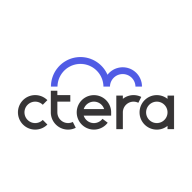

CTERA Enterprise File Services Platform and Dell PowerStore are competing solutions in enterprise data management. Dell PowerStore seems to have the upper hand in features with strong integration capabilities and scalable storage providing long-term benefits that justify its initial investment.
Features: CTERA focuses on secure file sharing, offline access, and effective pricing strategies to enhance ROI quickly. Dell PowerStore offers flexible integration through VMware environments, impressive scalability options, and innovative machine learning for automation. Its AI and machine learning capabilities enhance IT operations and include advanced deduplication and compression features.
Room for Improvement: CTERA could improve in deployment speed and customer service robustness. Dell PowerStore could benefit from better cost management and initial investment reduction. Improved data reduction ratio offerings would also enhance Dell PowerStore's appeal. Simplifying its complex integration process could lead to better user experiences.
Ease of Deployment and Customer Service: Dell PowerStore's deployment is streamlined, with comprehensive customer support that outshines competitors. CTERA's deployment is effective but overshadowed by Dell's robust support structures that facilitate user progression.
Pricing and ROI: CTERA is competitively priced with setup costs that encourage quicker returns on investment. Dell PowerStore requires a higher investment upfront but supports performance gains and cost efficiencies over time, delivering compelling value through its feature set.
Adding SSD storage to Windows file servers is expensive, and we no longer need to back up those devices.
I am positive that CTERA has helped reduce the total cost of ownership by eliminating the need for manual storage management and reducing storage service processes.
If you purchase storage with 300 terabytes, you can easily achieve one petabyte of effective capacity.
It's been trouble-free the entire time, with very high performance, as it has been designed and built properly.
We have reduced infrastructure but the same performance.
They swiftly address concerns and take ownership of the call, providing a very satisfactory support experience.
High-priority issues are handled promptly.
I would rate their support a ten out of ten.
If necessary, they will search for a specialist within their Dell network who we can approach with our questions.
I would rate the technical support of Dell PowerStore between nine and ten out of ten.
They're responsive, knowledgeable, and have a quick turnaround.
If we need to upgrade CPU and memory, we should be able to do that without a license upgrade.
CTERA is a very scalable product, allowing us to grow.
It offers good scalability options, including vertical and outward scalability.
The solution's scalability is a ten out of ten.
The customer likely exceeds 20,000 users globally.
You can create as many tools as needed, providing scalability based on the use case.
It has been pretty stable since then.
We had things deployed for years, and we were suddenly getting cloud sync issues that were crashing our sites.
It is very stable and reliable.
When I removed all the cables, it failed over within five minutes.
There are no bugs or glitches and it doesn't crash or freeze.
I would rate the stability of Dell PowerStore as ten out of ten.
AI and automation features could enhance the platform, such as AI-powered search, predictive storage analytics, and intelligent alerts for proactive monitoring.
It would help to have a global single-pane-of-glass view of all my CTERA devices.
One suggested improvement for the CTERA Enterprise File Services Platform is the ability to distribute data across multiple active backend storage nodes rather than the current limitation of a single active node.
If you want to delve into where your I/Os are going, the reporting might need more in-depth information to make informed decisions.
In my organization, we have had to go through two weeks with no replication, which is not very handy for our production environment.
Something needs to be done with the caching to ensure that if some issue occurs, there needs to be an ability to disable caching during maintenance to make it static, safe, and good.
Unlike other solutions that require hardware purchases, CTERA offers software licensing with flexibility across multiple infrastructure providers.
CTERA's pricing seems to be on par with some of the other players, such as Nasuni and Azure.
I find the pricing reasonable.
Likely the cost is $400,000 whereas IBM may be $250,000.
Based on my experience, the cost of Dell PowerStore for around 500 GB of capacity is very competitive compared to any other platform in the market.
There's no need to pay for a license; it's all-inclusive.
As soon as something is written to the device, CTERA copies it to the cloud, where it's versioned with snapshots so we can recover it.
A vital advantage of this platform is its instantaneous recovery capability, allowing seamless access to a secondary gateway if the primary one fails.
It is a three-in-one solution for us. It is a file-sharing platform, an archiving solution, and also a backup solution.
The solution promotes data reduction, often meeting the compression ratio.
The PowerStore's compression ratio is even higher than the Unity system.
The deduplication part of the solution is valuable since, as a user, you get more space for less money.


The CTERA Enterprise File Services Platform provides a cloud-native global file system over public and private object storage, revolutionizing the world of hybrid cloud data solutions. Enhanced by a rich data services ecosystem, CTERA enables enterprises to gain full control of their data for optimal edge performance, data insight, and governance. The platform focuses on security, providing features like data encryption, access controls, and ransomware protection. Centralized management tools enable efficient data control and monitoring. The platform is being used to replace legacy NAS and file servers, especially at remote locations, and simplify backup and disaster recovery of file data while providing the flexibility of multi-cloud deployments with infinite scalability. CTERA is at the core of hybrid cloud transformations of some of the world’s largest banks, healthcare organizations, global media groups, and government agencies, in deployments that scale to tens of petabytes.
Dell PowerStore stands out for its high performance, flexibility, and easy integration with VMware. It offers notable data compression and deduplication capabilities while providing powerful NVMe support and machine learning to optimize IT operations.
Dell PowerStore is designed to offer a comprehensive approach to IT infrastructure by enhancing performance and simplifying management. It is particularly suitable for companies that require scalable solutions to increase compute or capacity independently. Featuring built-in intelligence, PowerStore allows efficient storage consolidation and reduced footprint, while integration with CloudIQ enhances monitoring and analytics. However, there are areas for improvement, such as stability, enterprise features, and the user interface. Pricing is high, and support responsiveness needs attention. Organizations primarily use PowerStore for VMware environments, storage, and data protection, supporting high-performance databases and VMware workloads. It is utilized in data centers for disaster recovery and hybrid setups.
What are the key features of Dell PowerStore?In industries like IT, finance, and healthcare, Dell PowerStore supports efficient data management and enhances infrastructure performance. Organizations leverage it to manage extensive data, streamline virtualization processes, and facilitate migration from legacy systems, while integrating cloud and on-premises infrastructures for improved operations.
We monitor all NAS reviews to prevent fraudulent reviews and keep review quality high. We do not post reviews by company employees or direct competitors. We validate each review for authenticity via cross-reference with LinkedIn, and personal follow-up with the reviewer when necessary.